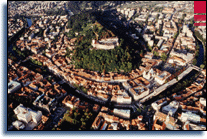Prešern Square
Congress Square
Town Hall
Town Square and Old
Square
Cobbler's Bridge
The Market
Dragon Bridge
Plečnik's Ljubljana
Ljubljana Castle
Ljubljana in the fine arts
Musical tradition and the contemporary music scene
Theatre
The University of Ljubljana
More about Ljubljana: http://www.mesto-lj.si
If Ljubljana is the heart of Slovenia, the castle perched on a hill in the city centre is the cradle of this city. Without a castle there would be no Ljubljana. Grad (the castle hill) and its fortress, Ljubljana castle, are a natural bequest. These two features flow into the symbol and distinguishing feature of the city of Ljubljana. Thus Ljubljana is ranked among the European cities whose Medieval origin is recognised by a castle standing on a rise and the walled city below. |
 Ljubljana Castle (© Ljubljana Promotion Centre) |
Archaeological research has proven the continuous presence of man on Grad since the 12th century BC. Here prehistory meets with the Middle Ages, because the road to the Medieval castle ran along the ramparts of the prehistoric sconce.
The present castle is younger than the one first mentioned as the headquarters of the feudal dominion of the Spanheim Carinthian Dukes. Between 1220 and 1246 they founded the city below the castle, in the natural setting of the Ljubljana gateway. In 1335 the castle which was the centre of Kranjska province for many years, became the hereditary property of the Hapsburgs. The present castle which is larger than former ones, is the work of Duke and later Emperor Frederik III. It originated from a deliberate plan over some decades in the second half of the 15th century to build a fortress with a spacious courtyard within a strong circular walled perimeter comprising corner towers and two entrance towers. Besides the gothic castle chapel which was consecrated in 1489 all the present interior castle buildings originated from the 16th and 17th centuries to from the principal structures and characteristic silhouette of the castle. Not until 1848 did the dominant feature of the viewing tower appear in the castle complex, as could be seen from Valvasor's pictures.
The golden age of Ljubljana castle coincides with the time when the castle was the headquarters of the provincial governor Lenkovič at around 1600. By 1814 it was in such a poor condition that it was used as a prison for a certain time. In 1905 the Ljubljana city authorities purchased it from the state. Since that time the most ambitious plans of the city were in one way or another linked to the castle. The famous architect Jože Plečnik viewed the castle as the crown of the city and the Slovene cultural acropolis.
In 1962-63 the last castle residents obtained accommodation in the city and the first systematic examination and restoration of the castle could begin.
The modern layout of the castle as a monument with new functions is linked to the life of the city as close as possible in order to interweave arts and culture, and provide the catering and tourist facilities.
In the first phase of restoration that took place between 1974 and 1984 approximately 40% of the castle structures were reinforced and covered again.
The city wedding suite is located in one section of the upper storeys. The ground floor is now a reception hall featuring a coffee-house which has already become a popular meeting-place for Ljubljana residents. The viewing tower itself has been open to the public for many years.
The restoration of Ljubljana Castle has been progressing successfully since 1988. In December, 1990, the pentagonal entrance tower was inaugurated, and in April, 1992, the Chapel of St. George, the Ljubljana patron saint who slew the dragon, was consecrated. The castle courtyard has already been paved and in most parts the gothic defence passage has been restored. It will encircle the whole castle and connect different sections.
The multipurpose areas, including The Long Room and conference hall with 400 seats will be suitable location for artistic performances, science and business meetings, club evenings, reception gatherings etc. Arts and culture will be therefore combined with promotional activities and tourist service.
Open to the visitors:
- Wedding Suite and Pentagonal Tower:
Tuesdays, Thursdays, Sundays 11.00 - 18.00;
Wednesdays, Fridays 13.00 - 18.00;
Saturdays, Mondays closed - Viewing Tower and Chapel:
Every day from 10.00 till dusk; - Café
11.00 - 24.00;
Sundays 10.00 - 23.00;
Mondays closed;
Ljubljanski grad / Ljubljana Castle
Tel: + 386 61 132 72 16